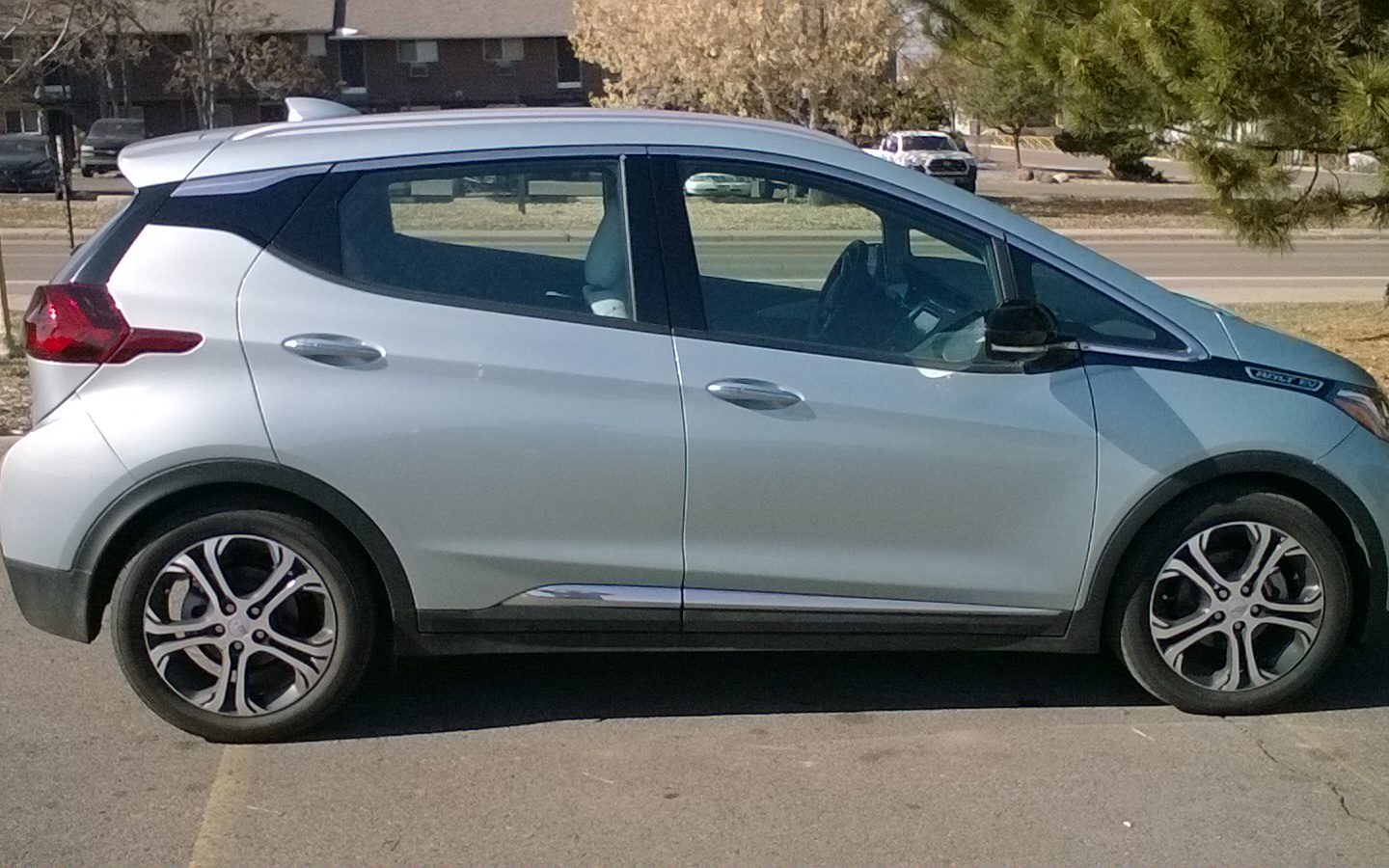When we bought our Toyota Prius, there were many doomsayers who told us how terrible the technology was going to be. The computerized transmission was a big risk, they said. The battery was going to fail. And, besides, you weren’t going to get the kind of MPGs that were advertised.

None of those warnings mattered. Sure, we rarely got 60 MPG for a full tank, but we did pretty well until recently. When I calculated the MPGs for our last road trip (the one where a plastic underbody panel tore loose just as we were going through customs–that’s another story), I saw that our efficiency had dropped down markedly–just about 36 MPG. While this is actually comparable to the average efficiency of new cars sold in the US, we decided it was time to replace our beloved family car of 15 years.
We decided that we were likely going to get a fully electric vehicle (why electric? I’ll explain all the reasons in another blog), but we also test drove some hybrids and EEVs (extended-range electric vehicles).
Quick Links to Drive Notes:
Prius Leaf Volt Bolt (1st Drive) Tesla Model 3 Kona Ioniq Hybrid Niro Hybrid Bolt (Overnight) Bolt (1000 Miles Later)
Toyota Prius
My wife Tracy read that it was a good idea to test drive a new model of the car you already have as a baseline. Otherwise, you’re likely to be impressed too much just at the newness of each car. Makes sense, so we started out by driving the new Prius. I am not as big a fan of the new styling on the Prius–they’re trying to shed the car’s station-wagon image and make it cooler. This is okay, but we essentially need it as a family car, so the change didn’t matter to us.
It was indeed a good reference point driving the new Prius. We test drove it up the hill on I-70, which we’d done just a week or so before in our old car, and the difference was stark. The car had great power going up the hill, easily exceeding the speed limit on the climb, despite keeping the AC on the whole time. Frankly, it’s a solid car, and I might have pushed harder for it if we only looking at hybrids.
The biggest turnoff, though, was the salesman’s attitude. He didn’t know much about the car, and wasn’t really trying to sell it. He didn’t care if we bought it because the dealership mostly liked to sell big trucks and SUVs, which accounted for more than 90% of their sales, he said. Plus, Toyota itself isn’t prioritizing alternate-fuel vehicles. They don’t have an EV on the market in the US. The final nail in the coffin? We’d used that dealership for service for about ten years, and we hated them. So we passed on the Prius.
Nissan Leaf
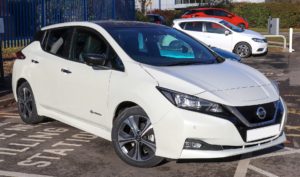
The Leaf was our first true EV, and we were pretty excited. We’d looked at one in the mall a little while earlier, and enjoyed the styling of the car. However, our test drive was disappointing.
Mostly, I think, the problem was the salesperson–again. He was a young guy and new at the dealership. He didn’t even have his own card! While he knew a little about the car, his knowledge was superficial, and he didn’t know how to show off the features to good effect. He was especially lacking when it came to the test drive route. He didn’t know where to recommend we should go, so we ended up on bland city streets where the car didn’t feel like anything special. The gear shift lever is an interesting design on this car, and I thought it would be cool once I got used to it, but as it was, it was distracting, and I never really got a feel for the instrument cluster.
Otherwise, the car was fine. Decent cargo space, although not what we were used to with our Prius. We put it on our “maybe” list and considered we’d come back for a second test drive. However, we knew that if we wanted to get it, we couldn’t go with the standard model–we wanted to get the upgraded battery pack for extended range (226 miles, compared to only 156 miles–although this is likely enough for most of our needs).
Chevy Volt
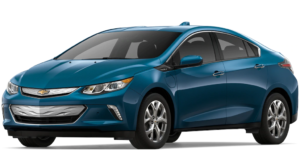
We decided to ride our bikes down to our local Chevy dealer (Emich). Tracy’s dad, Gordon, had decided he was also in the market for a new car and wanted to visit dealerships with us, so we met him there. Tracy immediately fell in love with the color of the Volt we saw on the lot. (It was Pacific Blue Metallic and the color looked so good in the midmorning sunlight, we thought about buying the car off the lot right then and there.)
We took it for a test drive, and there were some things to like about the car (other than the color). It really zips. You put your foot down and you feel the instant torque of the EV, which makes it fun. It was easy to drive–all the components were in a good location, and it was easy to get a good view of all the necessary instruments. The car also benefited from the fact that the dealership had an “EV specialist,” who knew all about the car and could explain the benefits of it.
However, it quickly became clear that this was not the car for us. One important consideration was the headroom in the back seat. The car has a low, sporty profile that makes it look cool and contributes to the fun of driving it. But the swoop of the roof skims so close over the head of passengers in the back seat that it induces claustrophobia. Our 13yo son is taller than I am, and he needs room. Plus the car is quite narrow, so it’s a tight squeeze for three people to sit across. But the biggest issue is that while they describe the Volt as a plug-in hybrid, it’s not actually a hybrid, it’s an EEV.
Hybrids vs. EEVs
A hybrid is a gas-driven car which has an electric motor that can also propel the car. It has the standard transmission of a typical gas car, and generally operates just like a regular car, just using the electric motor to supplement the gasoline engine. Batteries collect surplus energy to drive the electric motor. An extended-range EV doesn’t have a normal transmission, and uses only the electric motor to power the wheels. Ideally, it drives just using the electricity stored in the batteries that you get from plugging the car in. However, when the battery runs out, the electric motor kicks in as a generator to recharge the batteries.
The problem is that the Volt’s generator isn’t particularly efficient. When it was running, the car’s efficiency was only 37 MPG, comparable to the 15 yo Prius we were replacing. For that efficiency, there’s no point in introducing the trouble and maintenance of a gasoline engine (especially a GM engine).
Chevy Bolt (First Test Drive)
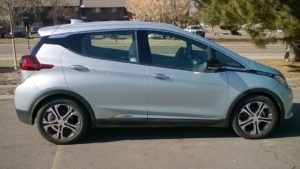
We drove the Bolt right after the Volt. The first impression was that it had almost all of the benefits of the Volt, and none of the drawbacks. It’s a zippy car to drive, too. Even when it’s not in “sport” mode, you can easily peal out from any stop, and you have all the acceleration you need at all speeds up to highway speed. The instrument cluster is intuitive and easy to use.
Because it has a more vertical build, there is plenty of headroom. This is despite the fact that it has what they describe as “stadium seating”–the rear seats are higher than the front seats to give passengers in the back seats a clearer view. Really, this is great a case of turning a negative into a positive. The seats sit on top of the large inverter module, so raising them up created the space the engineers needed. Another benefit is that the car eliminates the “hump” in the middle of the floor in the backseat. Gasoline cars need this either for the drive train or for exhaust. This gives the car good foot room for all the passengers.
Perhaps the biggest limitation of the Bolt IMO is that it’s not as nimble through the turns as it might be. It has a wider turning radius than our Prius, and you can feel it doesn’t want to turn as tightly.
Tesla Model 3
I have to admit, I was pretty excited about the fact that there was a Tesla in our price range. True, it was at the upper end of our price range, but it was still in consideration. So we went in for a test drive. And, yeah, it deserves its reputation as a sporty car. The acceleration is amazing, and it handles really sweet. It’s got a sporty suspension so you really feel the road, which can be a good or bad thing depending on your preference. Its interior is just well crafted, and it feels quality. It made the Chevy Bolt’s interior feel cheap and plastic by comparison. Tracy loved the glass roof in particular. It felt so futuristic and cool.
There are many other attractive things about the car. Maintenance is super-easy–there’s only one fluid you’re likely to ever need to put in the car (windshield wiper). The Supercharger network is really impressive. You can go almost anywhere in the US, never stopping for more than a half hour thanks to the speed of the chargers. The car display is set up to easily track the network so you can just get in the car, pick a destination, and go. We did find out, though, that the system breaks down if you want to drive to Canada. Because our last road trip was to Winnipeg, we tried to plan a similar one with a Tesla. It was fine until we go to Minnesota. You could charge up there but had to kind of wing it with low-voltage chargers in Winnipeg.
Too Techie, Too Fancy
I’m sure that many people would also find the cell phone integration appealing. You can control many aspects of the car with the app, and your phone is your key. If you’re the kind of person who never goes anywhere without your phone, this is really easy. If you’re like me, the kind of person who almost never carries his phone, the alternative key, a little card thingamabob, is not a good alternative.
In addition, I didn’t really like the interface. Everything goes through the tablet in the middle, and is controlled by two small knobbies on the wheel. While this streamlined control system makes for a sleek appearance, I found it hard to utilize. I thought it was particularly difficult to try to change the controls from audio to adjusting my mirrors while I was driving. Tracy also had a hard time with the turning signals. They have a two-setting control–you can either have them come on for a few seconds for lane changes or longer for true turns, and she had a hard time getting it into the right mode.
I’ll admit: if cost were no issue, I’d seriously consider the Tesla and fiddle more with the controls to see if I could adapt to them. But we can’t ignore cost, so we relegated the Model 3 to second-tier status. Between the tech integration, the price, and the fact that it just felt too fancy for us, it was clear this wasn’t the right choice for us.
Hyundai Kona
One of the biggest obstacles in trying to buy an EV is just finding them. Most manufacturers in the US make an electric car these days, but good luck finding one in Colorado. Hopefully this will improve thanks to a deal between lawmakers and auto manufacturers. However, for us we had to accept that we weren’t likely to find many of the cars we wanted to consider, and for some, like the Hyundai Kona, we had to drive over 50 miles.
We were happy when they promptly rolled one out for us to test drive. One thing to note about the Kona: it’s an EV version of a regular car, so it’s not designed as an EV from the ground up. You can see this looking into the engine compartment, where the electric components look a little off. But its specs are impeccable as far as range and efficiency.
Sluggish and Small
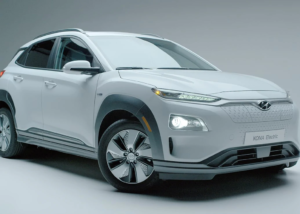
I found the controls not as intuitive as the Bolt, and I also found the pickup to be a lot less spry. Of course, I expected it to be less than the Tesla, but it felt like it was less than the Bolt. It still felt good, but I missed the thrill. I’ve read a lot of reviews that talk about the speediness of the car, so maybe I didn’t really have a chance to test it, but I did get to merge it onto the highway, so I feel like I got to give it a decent chance.
The big problem for us, though, was in the back seat. We had the kids along with us, so we sat our tall, skinny 13yo in the back seat and he immediately started complaining. It was cramped, which surprised us, and set us into panic mode. We had never considered that there might not be enough legroom in any of these cars for the kids. The Kona has more cargo space than other EVs, but it’s at the expense of the back seat, and since our kids ride in the car every day, that’s our priority.
Hyundai Ioniq Hybrid
The Hyundai Ioniq immediately won points with me because of its styling, which was reminiscent of the Prius. However, it lost points because the model they had on the lot had a dead battery. We also weren’t considering the EV because the range was too low to be our daily car (124 mi/charge). However, Gordon was considering the hybrid version, so that’s what we drove. I also took a turn driving it, and felt it was reasonable compared to the Prius, perhaps a little better. The tall kid had decent room in the back seat.
I don’t actually remember a lot of the details about the hybrid because after we finished our test drive, the dealership pressured us to buy (our mistake–we went out on Labor Day weekend), so it kind of scrambled my memory of this car.
Kia Niro Plug in Hybrid
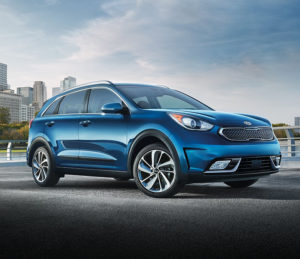
We would have liked to drive the Niro EV, but we didn’t have a chance. We did, however, get the opportunity to drive a Niro plug in hybrid, which Gordon was interested in. Unfortunately, the low battery charge didn’t let us operate it in EV mode for the test drive, but it drove well as a hybrid SUV. Good acceleration, fine maneuverability, and quite comfortable.
This is the one Gordon decided to buy, and, on the whole, he’s been happy with the car several weeks later. And, as a side note, he hasn’t had to go to the gas station after more than a month of driving.
Can You Drive It in EV Mode?
One complaint that pops up about the Niro is that it’s hard to drive it in EV mode. People complain that if you give the pedal any significant pressure, it engages the gasoline engine. I didn’t have this problem. We had to caravan back up to the dealership for Gordon to turn in his trade-in, and he let me drive the Niro. I was able to drive it in EV mode right up to the point that the EV range ran out. Beyond that, in fact, since I drove 6 miles after the point where it said I had 3 miles of EV range left.
Now, it could be that I just had the touch of a 15-year veteran hybrid driver, or maybe the fact that I was driving my father-in-law’s brand new car made me go light on the gas, but the fact remains that I drove it as an EV for upwards of 20 miles, including merging onto the highway without kicking it out of EV mode.
Bolt Overnight Test Drive
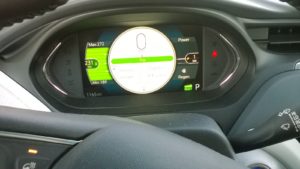
Next, we decided to take advantage of the Chevy dealership’s offer to take the Bolt for an overnight test drive. Tracy had read some things in other reviews that concerned her (notably that the interior of the car could create blinding glare when the sun was low), and we wanted to make sure the kids fit properly. Tracy noted the time when the glare was likely to be bad and took the car out at that time. No problems. The automatic lights are a good feature, and I like how they’re directed at a low level so they don’t illuminate more than you need to see when driving. I can’t help but feel that helps control light pollution, too.
We are also happy to report that our 13-year-old fits just fine in the back seat. The space isn’t as generous as the Prius, but it’s adequate, and the stadium seating helps make the seat comfortable for his long legs.
I took the car out at night and drove it on the highway. I loved the speed for merging, and the “neon” strips in the interior are really cool in the dark. To test the sound system for all the types of music I like to listen to, I also created a custom playlist. Turns out, I really loved the sound. We took it shopping and determined that the cargo space is more than adequate for most of our routine shopping trips. Of course, we won’t be fitting a pre-assembled exercise bike in the back, but it’s still good.
We decided this was the car for us.
1000 Miles Later . . .
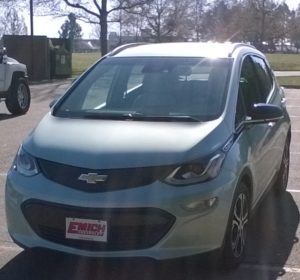
Because it’s taken me a while to actually finish this blog, we’ve had the car for over a month now and have logged more than 1000 miles with no tailpipe emissions. I’m not just glad of that for the planet, but every time I pass a bicyclist or a pedestrian, I’m glad that I’m not going to choke them with deadly fumes. I’ve been on the receiving end of that often enough that I’m happy not to pass it on to others.
So, how do we like it? It’s great. The convenience of never needing to go to the gas station is cool, and we’ve never been in a situation where range has been an issue. We generally try to charge it up fully over the weekend, then just charge it during the day between dropping kids off at school and picking them up, when the solar panels are producing the most electricity. Overall our efficiency is about 4.5 mi/kWh, which is not bad at all.
I love having the speed when I want it. I can dust pretty much everybody at the stop light if I want to (though the efficiency monitor goes yellow or orange sometimes). Putting the car in low mode lets you practice one-pedal driving–I almost never use my brakes to stop, just let up on the throttle and let the regen take back the energy. I continue to enjoy the sound, and the cool interior lights make for fun night driving. The automatic lights take some time to get used to, but I’m happy that it has them.
Driving the Bolt in the Snow
We’ve even had enough cold snaps to tell us how it performs in the cold, snow, and ice. The range definitely drops when you’re driving in the cold, but, again, never so much that we’re in danger of not being able to drive the distance we need to. Because of the range effects, I use the heat less, including the window defogger, which I sometimes turn on and off to keep the windows clear. Heated seats and steering wheel make for cozy driving in most temperatures. Today, it was down to 16 F, and I did turn the heat on for my feet.
The speed of the electric can obviously be a bit of a problem in the snow and ice. But it’s the same as with any other car–you just need to be light on the throttle and the brake. Go slow. Give yourself time for braking and don’t try to go too fast through a turn. I did have a moment this morning where I was trying to get started on a hill and I slid and slid. I had to tack against the slope, meandering into the next lane to get speed. But this wasn’t the fact that it was an EV. The road was pure ice and ICE cars ahead and behind were also spinning their wheels. The one behind me was still trying to get moving when I crested the hill.
EVs Are Ready for Prime Time
Based on our test drives and our experience driving it, I do not hesitate to recommend the Bolt for anyone considering a new car. Like the Prius before it, it’s a technological leap that is just a normal car. Other than the cost, you make no sacrifice to drive this car compared to any other. EVs are definitely ready to take over as the dominant vehicle for city driving, including driving to neighboring cities in places like the Front Range, where there are several within a 100-mile radius. Road trips are a little different. I’ll report back on that when I have the opportunity to test it.

